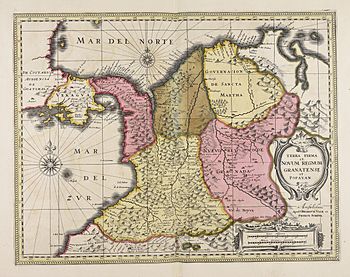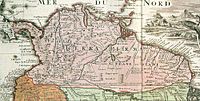New Kingdom of Granada facts for kids
Quick facts for kids
New Kingdom of Granada
Kingdom of the New Granada Nuevo Reino de Granada
Reino de la Nueva Granada |
|||||||
|---|---|---|---|---|---|---|---|
| 1538–1821 | |||||||
|
|
|||||||

The New Kingdom of Granada
|
|||||||
| Status | Ultramarine Province of the Spanish Empire | ||||||
| Capital | Santa Fe de Bogotá | ||||||
| Common languages | Castilian | ||||||
| Religion | Catholic | ||||||
| Government | Monarchy | ||||||
| King | |||||||
| Viceroy | |||||||
| Historical era | Spanish colonization of the Americas | ||||||
|
• Established
|
1538 | ||||||
|
• Viceroyalty established.
|
July 17, 1712 | ||||||
|
• Viceroyalty suppressed; kingdom autonomous again
|
November 5, 1723 | ||||||
|
• Disestablished
|
August 20 1821 | ||||||
| Currency | Real | ||||||
|
|||||||
| Today part of | Colombia Panama |
||||||
The New Kingdom of Granada (Spanish: Nuevo Reino de Granada) was a group of Spanish colonial areas in northern South America. It existed mainly in what is now Colombia. Spanish leaders called presidents governed it from the city of Santafé.
The Spanish conquistadors (explorers and conquerors) first set up this area as a province. It was part of the Viceroyalty of Peru, but it had some independence. In 1549, the Spanish king created a special court called the Audiencia to help rule the area. Later, the New Kingdom of Granada became the Viceroyalty of New Granada in 1717 and then permanently in 1739. The kingdom ended in 1819 when new independent states were formed.
Contents
History of New Granada: How it Began
The Spanish first settled in this region in 1514. They built important cities like Santa Marta in 1525 and Cartagena in 1533. These cities helped Spain control the coast. From there, they began to explore inland.
Spanish Exploration and Founding Cities
In 1536, the conquistador Gonzalo Jiménez de Quesada led an expedition. He traveled along the Magdalena River into the Andes mountains. There, his forces fought and defeated the powerful Muisca.
Quesada then founded the city of Santa Fé de Bogotá, which is now Bogotá. He named the entire region El nuevo reino de Granada. This name honored Granada, the last part of Spain that was taken back from the Moors.
Changes in Leadership and Control
Gonzalo Jiménez de Quesada left for Spain in May 1539. His brother, Hernán, took over the colony. However, Hernán lost control in 1540. Emperor Charles V gave the right to rule the area to another conquistador, Sebastián de Belalcázar. Belalcázar had come from what is now Ecuador and became the governor of Popayán.
How the Government Was Organized
To better manage the new lands, Emperor Charles V ordered a special court to be set up. This court was called an audiencia. It was established in Santafé de Bogotá in 1549. This audiencia had both executive (governing) and judicial (court) powers.
List of Governors of New Granada
These are some of the early governors who ruled the New Kingdom of Granada:
| Start Year | End Year | Governor |
|---|---|---|
| 1538 | 1539 | Gonzalo Jiménez de Quesada |
| 1539 | 1542 | Hernán Pérez de Quesada |
| 1542 | 1544 | Alonso Luis Fernández de Lugo |
| 1544 | 1545 | Lope Montalvo de Lugo |
| 1545 | 1546 | Pedro de Ursúa |
| 1546 | 1550 | Miguel Díez de Armendáriz |
| 1551 | 1558 | Juan de Montaño |
The Royal Audiencia: A Powerful Court
The Royal Audiencia was created by a royal order on July 17, 1549. It was given power over several provinces, including Santa Marta, Río de San Juan, Popayán, Guayana, and Cartagena de Indias.
The main job of the Audiencia was to provide justice. But it also oversaw how the government ran and how new areas were settled. Its first meeting was on April 7, 1550. It took place in a large house in the Plaza Mayor of Santafé de Bogotá. Today, the Colombian Palace of Justice stands on that same spot.
Later laws, like those from 1680, clearly defined the Audiencia's powers and the areas it controlled. It had a president, five judges, a crown attorney, and other officials. The president of the Audiencia was also the governor and captain general of the provinces. This meant he had a lot of power over the government and military. The judges focused on justice.
A big change happened in the 1700s. Communication between Lima (the capital of the Viceroyalty of Peru) and Bogotá was very slow. So, the Spanish decided to create a separate Viceroyalty of New Granada. This happened in 1717 and was reestablished permanently in 1739. The governor-president of Bogotá became the viceroy. This new viceroy had military and executive control over nearby areas like Quito and Venezuela.
How the New Kingdom Was Divided
The New Kingdom was organized into several smaller areas called Governments and Provinces. Each had its own capital and was founded by a specific person.
| Government/Province | Capital City | Year Established | Founder |
|---|---|---|---|
| Governorate of Santa Marta | Santa Marta | 1525 | Don Rodrigo de Bastidas |
| Governorate of Cartagena | Cartagena de Indias (Sometimes a capital of the Viceroyalty) |
1533 | Don Pedro de Heredia |
| Governorate of Popayán | Popayán | 1537 | Don Sebastián de Belalcázar |
| Province of Pasto | San Juan de Pasto | 1539 | Don Lorenzo de Aldana |
| Province of Santafé (de Bogotá), with the Province of Tunja, originally called the "New Kingdom of Granada" |
Santafé de Bogotá (Capital of the Viceroyalty) |
1538 | Don Gonzalo Jiménez de Quesada |
| Province of Tunja | Tunja | 1539 | Don Gonzalo Suárez Rendón |
| Province of Antioquia | Santa Fe de Antioquia | 1541 | Don Jorge Robledo |
| Province of Chocó | Quibdó | 1648 | Manuel Cañizales |
| Vast Province of Guyana (a special province) |
Angostura | 1595 | Don Antonio de Berrío |
Major Cities of the New Kingdom
Here are the largest cities in the New Kingdom of Granada based on a census from 1791:
- Cartagena de Indias – 154,304 people
- Santa Fé de Bogotá – 108,533 people
- Popayan – 56,783 people
- Santa Marta – 49,830 people
- Tunja – 43,850 people
- Mompóx – 24,332 people
See also
 In Spanish: Nuevo Reino de Granada para niños
In Spanish: Nuevo Reino de Granada para niños
- Patria Boba
- United Provinces of New Granada




